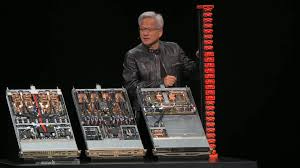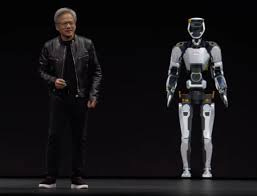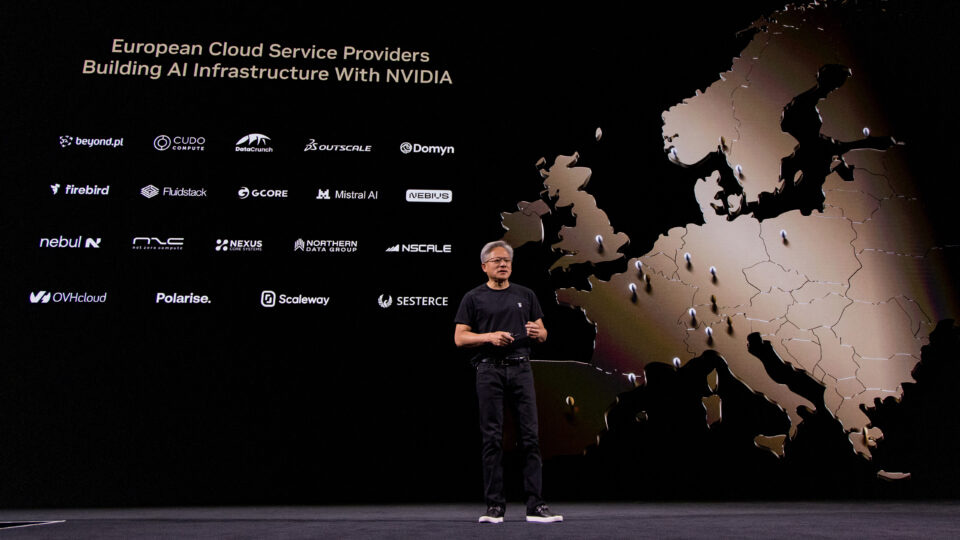Today, I had the pleasure of attending Jensen Huang's keynote at Nvidia GTC Paris. The keynote outlined a new era of computing, centered on the transition from traditional data centers to "AI Factories" that produce intelligence. This vision is powered by a new hardware architecture, a robust software ecosystem, and a clear roadmap toward agentic AI and robotics.
Here are the most significant announcements and themes:
1. The New Blackwell Architecture: A Leap in Computing Power
The centerpiece of the keynote was the announcement of the Grace Blackwell Superchip (GB200). This is not just an incremental update but a massive architectural leap.
Massive Performance Gain: Blackwell offers a 30- 40x performance increase for large language model (LLM) inference compared to the previous Hopper generation.
The "One Giant GPU" Concept: The key innovation is the NVLink Switch and Spine, which allows hundreds of GPUs (he mentioned connecting 144 Blackwell dies) to work together as a single, giant, virtual GPU with a unified memory space. This is critical for training and running the massive models of the future.
AI Factories, Not Just Data Centers: Huang framed this power in a new context. He repeatedly stated that data centers are no longer just for storing data but are becoming "AI Factories"—revenue-generating facilities that manufacture intelligence (tokens).
2. The Rise of Agentic AI and Robotics (Project GR00T)
The most futuristic and visually impressive part of the keynote was the focus on the next wave of AI: agents and robots.
Agentic AI: The next step beyond simple generative AI is "agentic AI"—systems that can reason, plan, use tools, and "talk to themselves" to solve multi-step problems. This requires significantly more computational power, which Blackwell is designed to provide.
Project GR00T: Huang unveiled Project GR00T, a foundation model for humanoid robots. This is designed to be a general-purpose AI that can understand natural language, observe human actions, and learn skills like coordination and dexterity to operate in the real world.
Simulation to Reality: The humanoid robot shown on stage (nicknamed "Greg") demonstrated skills learned entirely within the NVIDIA Omniverse simulation platform. This highlights NVIDIA's strategy of using physically accurate digital twins to train robots before they are deployed in the physical world.
3. Software and Ecosystem Enablement
Huang emphasized that NVIDIA's strategy is about providing an end-to-end platform, not just chips.
NIMs (NVIDIA Inference Microservices): To make AI accessible, NVIDIA is taking powerful open-source models (like Llama, Mistral) and optimizing them through "post-training." They are then packaged as NIMs, which are essentially pre-built, easy-to-deploy containers that any developer can use.
DGX Left-Turn: This is a new "supercloud" management platform that allows enterprises to deploy and manage their AI applications (NIMs) seamlessly across any environment—public clouds (AWS, GCP), regional clouds, and their own on-premise DGX systems.
Partnerships: He announced deep integrations with platforms like Hugging Face and the reasoning engine Perplexity to make these advanced models and tools widely available.
4. A Strong Focus on Building a Sovereign European AI Ecosystem
Given the Paris location, a major theme was empowering Europe to build its own AI infrastructure.
Building Sovereign AI: Huang detailed numerous partnerships with European telcos, cloud service providers, and national supercomputing centers to build out indigenous AI clouds.
A 10x Increase in Compute: He stated that these initiatives will increase the AI compute capacity in Europe by a factor of 10 in the next couple of years.
AI Technology Centers: NVIDIA is establishing AI technology centers across Europe to collaborate on research, upskill the local workforce, and foster a robust AI ecosystem.
Overall, the keynote painted a picture of an end-to-end computing platform—from silicon (Blackwell) to simulation (Omniverse) to software (NIMs) to robotics (GR00T)—designed to power the next industrial revolution driven by generative AI.
Q1: The scale of NVIDIA's investment in Europe and if there are plans to expand investment into Latin America, particularly Brazil.
Jensen's Answer: NVIDIA will be investing "billions" in Europe. They are starting seven AI research centers and already have a large footprint in the UK, France, Germany, and Nordic countries. He expressed a strong interest in Brazil, stating that if they were invited, he would love to go, recognizing the "great AI opportunity there," particularly in research and energy. He confirmed NVIDIA has not been invited yet.
Q2: On the rapid pace of AI innovation and the gap between hardware and software development, and how NVIDIA plans to bridge this gap.
Jensen's Answer: He states the key is to "start a long time ago." He cites NVIDIA's work on NVLink (started 12 years ago) and their silicon photonics system (started 5 years ago) as examples. The strategy is to anticipate future needs and start developing foundational technologies far in advance, even if it means creating the supply chain and licensing the tech to others to get the ecosystem moving.
Q3 A question about the fear that AI will eliminate white-collar jobs, citing a prediction that 50% of these jobs could vanish in the next five years.
Jensen's Answer: He "pretty much disagrees with almost everything" about that fear-based perspective. He argues:
AI is not scary: It's a powerful tool that should not be gatekept by a few companies. It should be democratized and developed in the open for safety and peer review.
Productivity creates jobs: Historically, when companies become more productive, they hire more people to pursue new ideas and expand. Productivity only leads to job losses if a company runs out of ideas.
Jobs will change, not just disappear: While some jobs will become obsolete, many new ones will be created. Human abilities will be augmented by AI, not simply replaced.
Q4: Noting the fear in Europe about "tech sovereignty" due to reliance on US tech solutions, and asking for Huang's thoughts on these discussions.
Jensen's Answer: He acknowledges that the world is interconnected. While diversity and redundancy in a supply chain are important for resilience, it's impossible to be completely independent. He advises a balanced approach: build sovereign capabilities where you can, but also form strong, reliable international partnerships, as it's not practical to reinvent everything.
Q5: Referencing a statement from Yann LeCun about the limitations of current AI models (hallucinations, prompt engineering, etc.), and asking if generative AI can become safe enough for widespread adoption in sensitive industries.
Jensen's Answer: Yes, it can. He uses the analogy of raising a child. A "pre-trained" model is like a kid who has read every book in the world (good and bad) but has no real-world experience. To make it reliable, you need:
Guardrails and fine-tuning: Teaching it rules and showing it the right way to do things.
Reasoning and Context: Giving it the ability to reason about a task and providing it with the right context (data) to perform that task.
Agentic AI: The next step is "agentic AI," where one AI's output is monitored and checked by many other specialized AIs, creating a highly regulated and safe system.
Q6: About the relationship with the French startup Mistral and the details of their new partnership.
Jensen's Answer: Mistral has a plan to become a "regional AI cloud" for Europe, similar to CoreWeave in the US. NVIDIA's role is to act as a catalyst by:
Connecting Mistral with financing opportunities.
Introducing them to enterprise customers.
Providing the essential AI infrastructure (hardware and software).
Q7: Asking for a reaction to the statement that NVIDIA is a "tech priest-hood" creating a future where true innovation is only accessible to a handful of organizations with the money to operate these AI factories, undoing the "bottom-up ethos" of tech.
Jensen's Answer: He pushes back strongly on this idea. He argues NVIDIA is doing the opposite:
Lowering the Cost of AI: Because their technology is improving 1,000 times faster than Moore's Law, the cost of AI computing is dropping dramatically. What cost billions a few years ago now costs millions, enabling smaller teams like Mistral to build state-of-the-art models.
Democratizing Access: He is actively working to ensure every country can have its own "sovereign AI" by building the necessary infrastructure. The data (culture, history, knowledge) belongs to the country, and NVIDIA provides the tools to turn that data into intelligence.
Enabling an Ecosystem: He describes NVIDIA's approach as hiring "contractors" (like OpenAI or service providers) for generic tasks, but also building specialized AI "in-house" and empowering others to do the same with their data.






